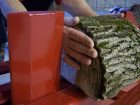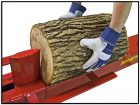
Split safely
By Chris Skalkos
Features Tech tipsWood splitters are profitable rental items in both the spring and the fall, but just like any other machine in your rental fleet, your success will hinge on the product’s safety record.
 Here’s how your customers may load a splitter if you do not tell them differently. Note how the hands are in the pinch points between the wedge and the log stop. Wood splitters are profitable rental items in both the spring and the fall
Here’s how your customers may load a splitter if you do not tell them differently. Note how the hands are in the pinch points between the wedge and the log stop. Wood splitters are profitable rental items in both the spring and the fallAlmost all hydraulic self-contained wood splitters on the market do the same thing: they are simple machines designed to split wood into smaller pieces. In addition to performance and maintenance, rental operators also need to consider safety and that starts with identifying the potential hazards that come with wood splitting machinery.
If you have been dealing with wood splitters for any amount of time, you have probably already discovered that not all wood splitters are made the same. There are many companies manufacturing a variety of wood splitters and knowing what to look for can make the difference when the safety of the machine is a factor in your purchasing decisions.
First and foremost for any rental operation is safety. It’s standard practice for rental professionals to educate customers about operating machinery safely. This ensures that the customer will be safe when using the machine and that your machine will be used with care on the jobsite.
Knowing that the wood splitters you are renting have been designed for operational safety helps manage this risk. Wood splitters are inherently dangerous if used improperly, but that is no different than renting out a chainsaw or a min-excavator.
Every wood splitter will have a pinch-point in the splitting zone where fingers can get crushed. This is where the knife or wedge meets the log stop, which is usually a flat plate of steel. The greater the surface area of the flat plate log stop or push plate the more surface area is presented to the operator to have fingers pinched. Some manufacturers have designed log stops with a smaller profile which presents less surface area for potential pinch-points when the operator is handling the wood during splitting.
Another contributing safety factor is fly-outs, where wood pieces or whole logs fly off the splitter striking the operator. This happens when the log is not pinched properly and the build-up of pressure causes the log to catapult off the splitter bed or causes split pieces of wood to fly outwards. This is something that can occur even when the splitter is being used correctly, especially if the logs being split have been cut on an angle.
Rental operators can completely remove this liability from their splitters by choosing a machine that has a log stop design that will hold the log firmly in place even if it has been cut on an angle. This prevents wood from flying off unexpectedly, making the machine much safer to operate.
The added benefit of a low profile log stop design will also allow pressure to be relieved around the sides so the wood can move laterally instead of building up uneven pressure and forcing the log to pop out. The narrow profile of the front of the log stop will always contact the wood in the centre of the frame. This keeps the pressure in the centre of the splitter causing less deflection which reduces friction and lengthens machine life.
In addition to limiting the build up of pressure, there are also dangers of hot hydraulic oil being sprayed over the operator caused by a hydraulic hose failure. A quality built wood splitter will use steel high pressure hydraulic tubes which keep the oil cooler and will leak before they burst greatly reducing this risk. In places where rubber hose is required, long weaker rubber hose should be replaced by one short high pressure hose designed for four times the nominal pressure used in these machines.
When using wood splitters rental operators can prevent customers from being injured, not only by educating them on the proper operation of the machine, but also on proper splitting techniques.
Start by telling them to “keep their hands on the bark.”
No matter what brand or style of wood splitter is being rented, most pinching injuries can be avoided by always handling logs on the bark side and not the ends of the log.
Even when the machine is turned off, holding blocks by the butt end can cause hands and fingers to be pinched if bumped between the push plate, a log-stop or the splitting head and the block. Accidents can be avoided by never handling the blocks or logs by the sawn ends. Always grab logs on the bark side.
For handling over-sized logs it is easier to grab them by the sawn ends only to place them on the shelf edge of the wood splitter, and then move the hands on the bark side to roll them into place for splitting. Understandably, it does feel awkward to grab the logs by the round instead of at the sawn ends, but emphasising this practice to customers will keep their hands and fingers away from pinch points at all times.
Most log splitter injuries occur when there is more than one person operating the machine. Hydraulic log splitters are designed so that the wedge or knife will stop when the operator lets go of the control handle so the operator can then safely handle wood pieces in the splitting zone. The safety of the one-person design is completely circumvented when a different person is controlling the movement of the knife. This can’t be emphasized enough to renters. Log splitters are meant for only one operator! Helpers stacking wood should never be near the splitting zone.
There are many other tips that will be listed in the owner’s manual regarding the safe operation of the machine and they should all be adhered to. If the rental operator can at least get these safety points across to the renter much of the common injuries associated with hydraulic log splitters can be avoided.
These are only a few factors to consider when choosing a safe wood splitter for your rental operation. Having the ability to identify the hazards and to clearly convey them to renters will greatly reduce risks and keep your customers renting and splitting safely.
Chris Skalkos is the marketing director for Split-Fire Sales Inc, in Norwich, Ontario.
Print this page


Leave a Reply